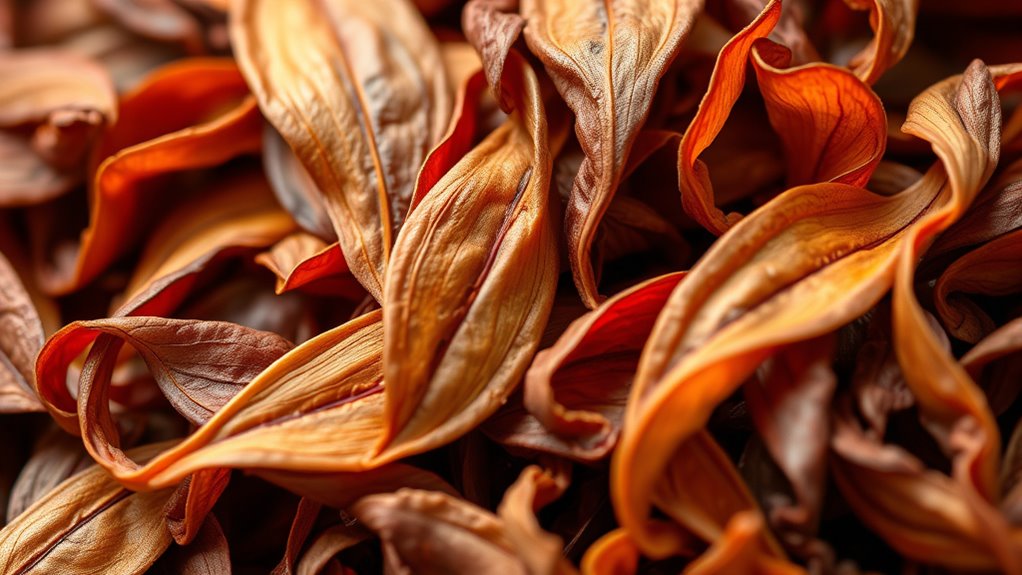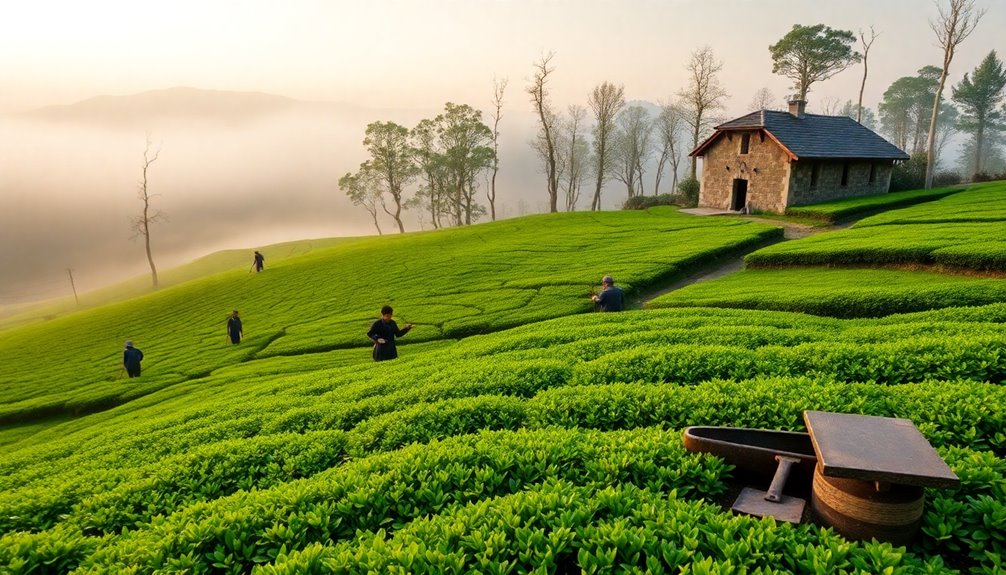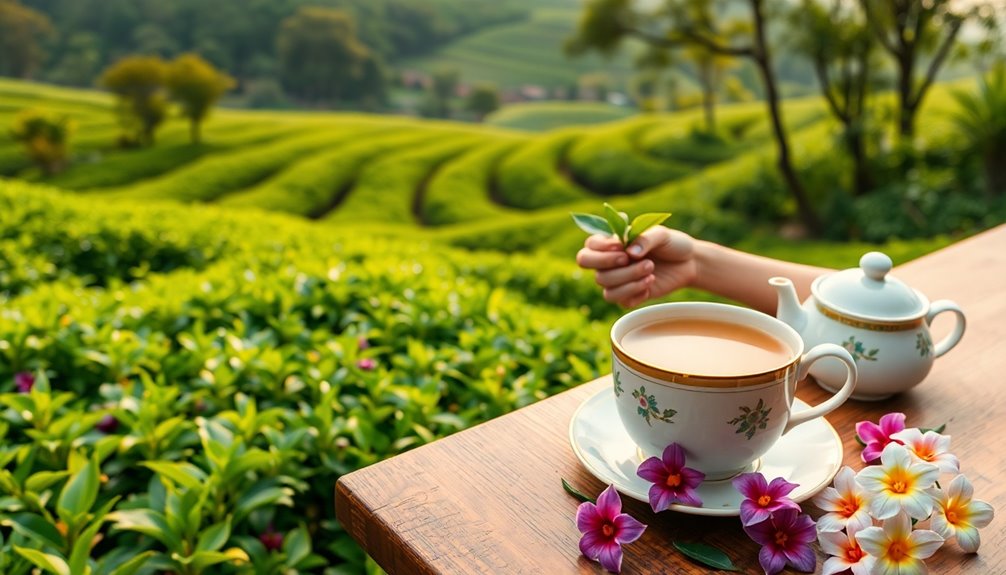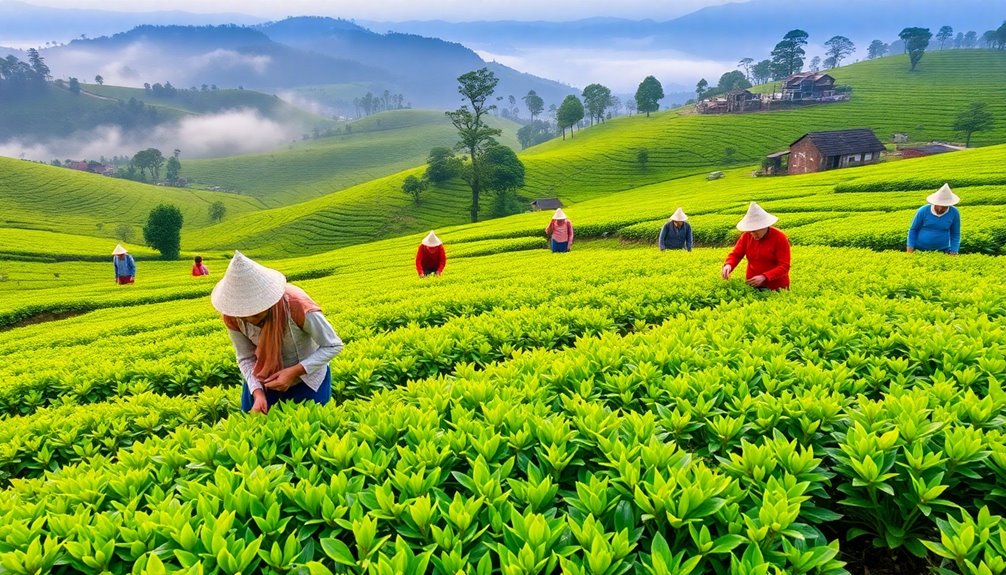The color spectrum of tea leaves reflects the level of oxidation they’ve experienced, which directly influences flavor and appearance. Light green leaves indicate minimal oxidation, preserving fresh, grassy notes, while darker brown or black leaves show extensive oxidation, resulting in bold, malty flavors. Observing these hues helps you identify the type of tea and its taste profile. Exploring further reveals how precise oxidation control creates the diverse teas we enjoy, so keep going to learn more.
Key Takeaways
- Different oxidation levels produce varying leaf colors, from bright green to dark brown or black.
- Visual cues like leaf color help identify tea type and its degree of oxidation.
- Minimal oxidation results in green leaves, indicating fresh, grassy flavor profiles.
- Fully oxidized leaves appear darker, signaling richer, bolder flavors.
- Processing control ensures the desired oxidation level, directly influencing the tea’s color spectrum.
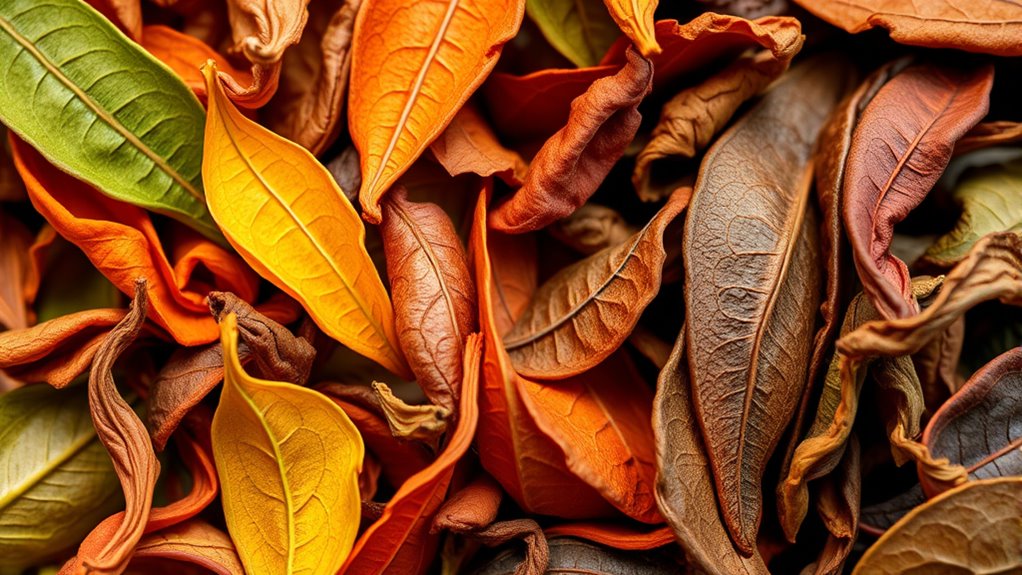
Have you ever wondered what causes the rust on your bike or the change in color on a sliced apple? These are everyday examples of oxidation, a chemical reaction where substances interact with oxygen, leading to visible changes. When it comes to tea leaves, oxidation plays a vital role in shaping their color and flavor. Understanding this process can help you appreciate the subtle differences among tea types and how they develop their unique qualities.
Oxidation causes color and flavor changes in tea leaves, much like rust or a sliced apple turning brown.
The fermentation process in tea production is central to oxidation, especially in black and oolong teas. During processing, tea leaves are deliberately exposed to air, allowing enzymes and oxygen to react with the leaf’s components. This controlled oxidation transforms the cellular structure, resulting in the deep amber and brown hues characteristic of black teas and the more complex shades found in oolong varieties. As the leaves oxidize, chemical compounds like polyphenols undergo transformations, which directly influence flavor development. You might notice that fully oxidized teas tend to have richer, bolder tastes, with notes of malty, fruity, or roasted flavors. Conversely, less oxidized teas like green tea retain a fresher, grassy profile because their oxidation process is halted early.
By understanding the fermentation process, you can better grasp how oxidation affects flavor development. As the tea leaves oxidize, they produce new aromatic compounds, which contribute to the complexity and depth you experience in each sip. The degree of oxidation determines whether the tea will be light and delicate or dark and robust. For example, a lightly oxidized green tea preserves the natural grassy and vegetal flavors, while a heavily oxidized black tea becomes more mellow, with caramel or chocolate undertones. This transformation isn’t just about color; it’s about the entire sensory experience, shaped by chemical reactions during oxidation.
The color spectrum of tea leaves is a visual indicator of their oxidation level. Green leaves indicate minimal oxidation, while darker leaves signal a higher degree of enzymatic activity. This visual cue helps you identify the type of tea and anticipate its flavor profile. The process is delicate—if oxidation is stopped too early or allowed to continue too long, the resulting tea might lose its desired qualities. That’s why skilled tea producers carefully control the fermentation process, ensuring ideal flavor development and consistent quality.
In essence, oxidation is the key to unlocking the diverse world of teas. It’s a natural, chemical dance that transforms raw leaves into a spectrum of colors and flavors, enriching your tasting experience. By paying attention to how tea leaves change during processing, you gain a deeper appreciation for the craftsmanship behind each cup and the science that makes it possible.
Frequently Asked Questions
How Does Oxidation Affect Tea Aroma?
When oxidation occurs, it considerably impacts your tea’s aroma. You’ll notice a richer, more complex scent as flavor development progresses. Oxidation enhances aroma complexity by transforming natural compounds, which releases new fragrant notes. This process can mellow sharp smells and bring out deeper, more inviting scents. So, as you enjoy your tea, remember that oxidation plays a key role in shaping its aromatic profile, making each sip more enticing.
Can Oxidation Levels Be Precisely Measured?
You can precisely measure oxidation levels by using spectroscopic analysis, which detects specific chemical markers associated with oxidation. This technique allows you to quantify the process more accurately than visual assessment alone. By analyzing the absorption spectra, you identify the concentration of key compounds, giving you a clear understanding of oxidation extent. This method offers a reliable, scientific way to evaluate tea leaf oxidation, ensuring consistency and quality control.
Does Oxidation Influence Tea Shelf Life?
They say “a stitch in time saves nine,” and the same applies to tea storage. Yes, oxidation influences your tea’s shelf life. Proper storage conditions and packaging materials prevent further oxidation, keeping tea fresh longer. Exposure to air, light, and moisture accelerates spoilage. To enjoy your tea at its best, store it in airtight containers in a cool, dark place, and avoid frequent opening.
Are There Health Benefits Linked to Oxidation Levels?
You might wonder if oxidation levels in tea impact your health. Higher oxidation can boost antioxidant properties, which help protect your cells from damage. However, excessive oxidation might reduce some health benefits or introduce unwanted compounds. Balancing oxidation levels guarantees ideal health implications, so choose teas with appropriate processing. Enjoying a variety of oxidized and unoxidized teas can maximize antioxidant intake and support your overall well-being.
How Does Climate Impact Tea Oxidation?
Climate variability considerably impacts tea oxidation by influencing growth conditions. When you consider oxidation control, you realize that temperature, humidity, and sunlight levels affect how tea leaves develop and oxidize. In warmer, more humid climates, oxidation tends to accelerate, altering flavor and color. Conversely, cooler, drier environments slow oxidation, allowing for more delicate flavors. Understanding these climate effects helps you manage processing techniques for ideal tea quality and consistency.
Conclusion
Now that you know how oxidation shapes tea leaf colors, you can appreciate the science behind each brew. Did you know that black tea undergoes nearly complete oxidation, transforming its color and flavor? This fascinating process influences over 80% of global tea consumption. So next time you sip your favorite cup, remember the intricate chemical dance happening inside. Understanding oxidation deepens your appreciation for tea’s vibrant spectrum and the craftsmanship behind every blend.

